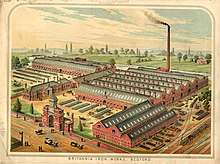James & Frederick Howard
James & Fred Howard of Bedford, later known simply as Howards, were one of the smaller English makers of agricultural machinery and steam traction engines.[1] At The Great Exhibition of 1851 they exhibited a range of horse-drawn implements.[2] After World War I, Howards became part of AGE, Agricultural & General Engineers, along with many of the other British makers of similar machinery.[3]

Traction engines
Howard traction engines are recognisable by their distinctive placement of their steam engine behind the boiler, rather than on top as for the far more common overtype. This gives them an unusually long and low appearance, with the flywheel set particularly low. This also requires the provision of a steam dome atop the boiler, an unusual arrangement for an English engine.[notes 1] Although usually plain in appearance and painted black, with little ornamentation compared to the later Edwardian engines, Howards carried very large brass nameplates on their boiler sides and smokebox door reading "James & Fredk Howard. Bedford. England".
They also built ploughing engines.[4][5] Unlike the better-known Fowlers, the Howard used a pair of winding drums. This allowed a single engine and an anchored return pulley to plough, rather than the Fowler system that used a pair of engines, each one pulling alternately. The two drums were too large to fit in the usual position beneath the boiler and so were moved to a horizontal axle behind the engine's scuttle, with a pair of sheaves beneath the boiler to guide the cables.
Surviving examples
Survivors are rare:
- Works Nº201 of 1872. A two-speed 9nhp traction engine, originally sold to Australia.
- Re-imported and restored by Tom Varley in 1980 and numbered 24.[6][7][8] Sold after his death to Peter Rigg of Todmorden.[9] Now carries the name Brittania [10]
External links
References
- In most English engines, the casting for the cylinder itself forms a steam dome.
- "J. and F. Howard". Grace's Guide.
- "Two-horse XX plough, four-horse plough and horse rake". Grace's Guide.
- "AGE - Agricultural and General Engineers". Grace's Guide.
- "Howard 8nhp ploughing engine". Bedfordshire Steam Rally 2006.
- "Pictures of Howard Ploughing Engines - Steam Scenes".
- "List of known exported engines" (PDF). 80. Archived from the original (PDF) on 2011-03-13.
- Marcel Gommers (1987). "Howard No24".
- "Howard No24". 1990. also a three-quarter view
- "J & F Howard Traction Engine 24, 1872. Cumbria steam gathering". 2005.
- "Howard General Purpose Engine, 201". Cumbria Steam Gathering 2003: Steam scenes. 24 July 2003.CS1 maint: location (link)